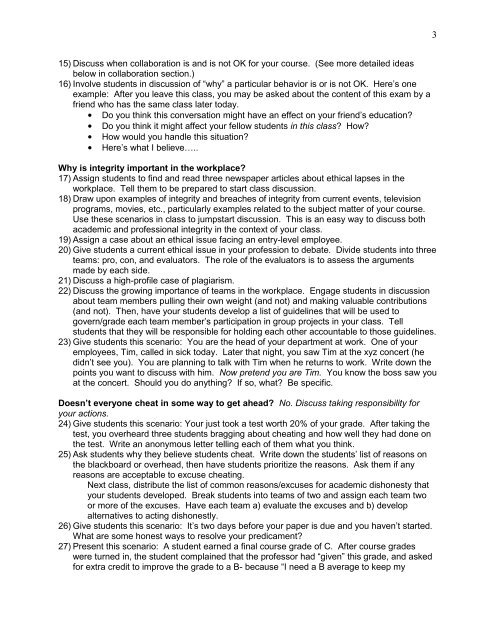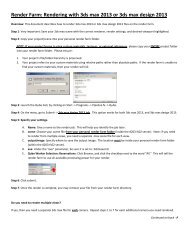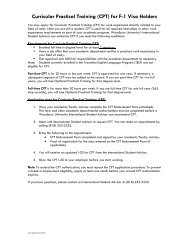50 Ways to Jumpstart Academic Integrity Discussions in Your Class
50 Ways to Jumpstart Academic Integrity Discussions in Your Class
50 Ways to Jumpstart Academic Integrity Discussions in Your Class
Create successful ePaper yourself
Turn your PDF publications into a flip-book with our unique Google optimized e-Paper software.
315) Discuss when collaboration is and is not OK for your course. (See more detailed ideasbelow <strong>in</strong> collaboration section.)16) Involve students <strong>in</strong> discussion of “why” a particular behavior is or is not OK. Here’s oneexample: After you leave this class, you may be asked about the content of this exam by afriend who has the same class later <strong>to</strong>day.• Do you th<strong>in</strong>k this conversation might have an effect on your friend’s education?• Do you th<strong>in</strong>k it might affect your fellow students <strong>in</strong> this class? How?• How would you handle this situation?• Here’s what I believe…..Why is <strong>in</strong>tegrity important <strong>in</strong> the workplace?17) Assign students <strong>to</strong> f<strong>in</strong>d and read three newspaper articles about ethical lapses <strong>in</strong> theworkplace. Tell them <strong>to</strong> be prepared <strong>to</strong> start class discussion.18) Draw upon examples of <strong>in</strong>tegrity and breaches of <strong>in</strong>tegrity from current events, televisionprograms, movies, etc., particularly examples related <strong>to</strong> the subject matter of your course.Use these scenarios <strong>in</strong> class <strong>to</strong> jumpstart discussion. This is an easy way <strong>to</strong> discuss bothacademic and professional <strong>in</strong>tegrity <strong>in</strong> the context of your class.19) Assign a case about an ethical issue fac<strong>in</strong>g an entry-level employee.20) Give students a current ethical issue <strong>in</strong> your profession <strong>to</strong> debate. Divide students <strong>in</strong><strong>to</strong> threeteams: pro, con, and evalua<strong>to</strong>rs. The role of the evalua<strong>to</strong>rs is <strong>to</strong> assess the argumentsmade by each side.21) Discuss a high-profile case of plagiarism.22) Discuss the grow<strong>in</strong>g importance of teams <strong>in</strong> the workplace. Engage students <strong>in</strong> discussionabout team members pull<strong>in</strong>g their own weight (and not) and mak<strong>in</strong>g valuable contributions(and not). Then, have your students develop a list of guidel<strong>in</strong>es that will be used <strong>to</strong>govern/grade each team member’s participation <strong>in</strong> group projects <strong>in</strong> your class. Tellstudents that they will be responsible for hold<strong>in</strong>g each other accountable <strong>to</strong> those guidel<strong>in</strong>es.23) Give students this scenario: You are the head of your department at work. One of youremployees, Tim, called <strong>in</strong> sick <strong>to</strong>day. Later that night, you saw Tim at the xyz concert (hedidn’t see you). You are plann<strong>in</strong>g <strong>to</strong> talk with Tim when he returns <strong>to</strong> work. Write down thepo<strong>in</strong>ts you want <strong>to</strong> discuss with him. Now pretend you are Tim. You know the boss saw youat the concert. Should you do anyth<strong>in</strong>g? If so, what? Be specific.Doesn’t everyone cheat <strong>in</strong> some way <strong>to</strong> get ahead? No. Discuss tak<strong>in</strong>g responsibility foryour actions.24) Give students this scenario: <strong>Your</strong> just <strong>to</strong>ok a test worth 20% of your grade. After tak<strong>in</strong>g thetest, you overheard three students bragg<strong>in</strong>g about cheat<strong>in</strong>g and how well they had done onthe test. Write an anonymous letter tell<strong>in</strong>g each of them what you th<strong>in</strong>k.25) Ask students why they believe students cheat. Write down the students’ list of reasons onthe blackboard or overhead, then have students prioritize the reasons. Ask them if anyreasons are acceptable <strong>to</strong> excuse cheat<strong>in</strong>g.Next class, distribute the list of common reasons/excuses for academic dishonesty thatyour students developed. Break students <strong>in</strong><strong>to</strong> teams of two and assign each team twoor more of the excuses. Have each team a) evaluate the excuses and b) developalternatives <strong>to</strong> act<strong>in</strong>g dishonestly.26) Give students this scenario: It’s two days before your paper is due and you haven’t started.What are some honest ways <strong>to</strong> resolve your predicament?27) Present this scenario: A student earned a f<strong>in</strong>al course grade of C. After course gradeswere turned <strong>in</strong>, the student compla<strong>in</strong>ed that the professor had “given” this grade, and askedfor extra credit <strong>to</strong> improve the grade <strong>to</strong> a B- because “I need a B average <strong>to</strong> keep my








